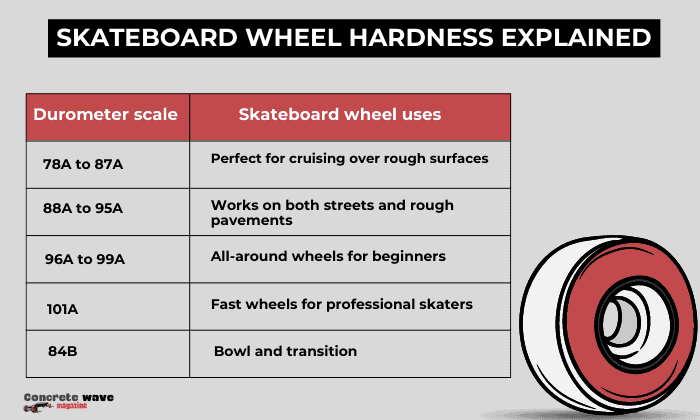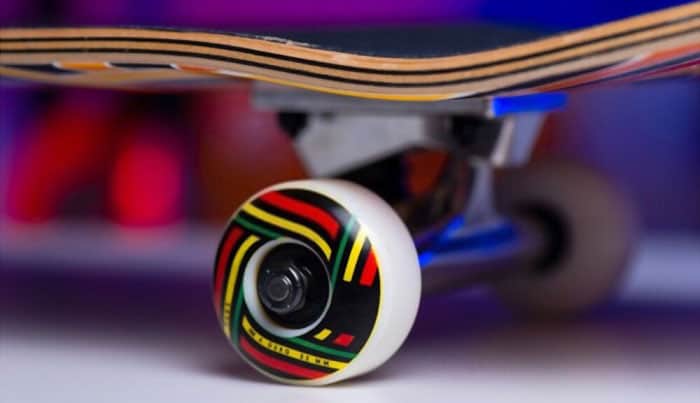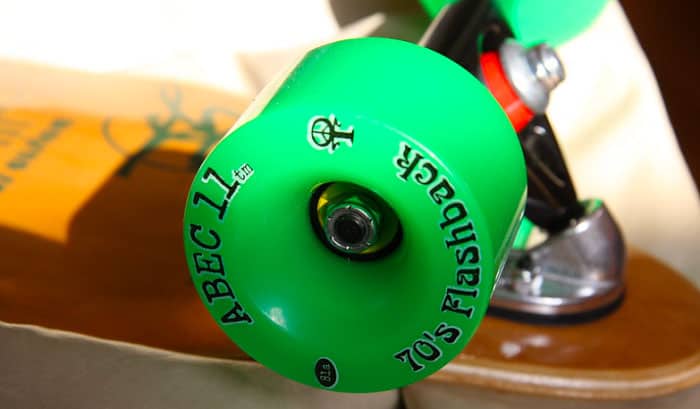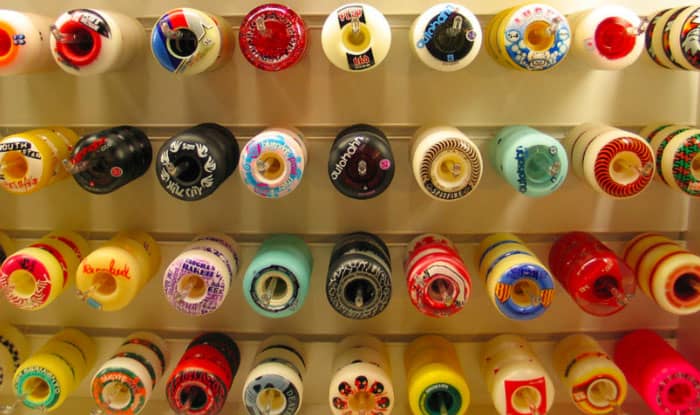
Skateboards do not have just one configuration, and neither do their parts. For example, the trucks vary in axle widths to match different deck sizes, while the concavity affects how suitable the deck is for flip tricks.
These differences make skateboards usable for all ages, skating styles, and levels. Also included among these differences is the skate wheels’ hardness levels.
Today, we will have the skateboard wheel hardness explained to enlighten you on what the numbers on these rollers indicate. They could be for the streets, parks, chill rides, or other skating styles. Keep reading because we’ll bring you closer to setting up the ideal skateboard.
| Durometer scale | Skateboard wheel uses |
| 78A to 87A | Perfect for cruising over rough surfaces |
| 88A to 95A | Works on both streets and rough pavements |
| 96A to 99A | All-around wheels for beginners |
| 101A | Fast wheels for professional skaters |
| 84B | Bowl and transition |
Table of Contents
What Does a Skateboard Wheel’s Hardness Represent?

To say that all pillows are soft could undermine the quality of some branded bed cushions. The good thing about skateboard wheels is their hardness does not indicate their quality. The reason is each level in the wheel hardness scale serves a valuable purpose.
Skate wheels hardness depicts the toughness of the material used to create them. But how do we measure wheel hardness?
What’s soft for one skater may not be the same for another. Hence, many brands implement the durometer skateboard wheels system when measuring and indicating the wheel’s hardness level.
So, when do we say a wheel is soft or hard?
The durometer system uses two scales: A and B. Both scales range from 0 to 100, with the highest number being the hardest. With the durometer meaning two scales possibly, how do we distinguish each? Let’s begin with the durometer A scale.
It is a more popular scale used for skateboard wheels. Often, you see two digits embossed or printed on the urethane roller’s body, followed by the letter A. That’s the wheel’s hardness.
So, on a 0-to-100-scale, where do soft and hard skateboard wheels dwell? Refer to this list below.
- 78A to 87A – This skateboard wheel softness is ideal for longboards and skating over rough surfaces.
- 88A to 95A – Moderately hard wheels for the streets and bumpy trails
- 96A to 99A – Speedy and grippy, but perfect for beginners too
Are there skateboard wheels harder than the ones tagged 100A? Yes. These are the stiffest wheels used today. These rollers have a minimum hardness of 101A. And often, they are popular options for professional skateboarders due to their speed.
What about the durometer B scale?
The wheels on the durometer B group exceed the A range in actual hardness. But the durometer B measures 20 points lower than the A scale based on the longboard wheel hardness chart. Hence, a 100A skateboard wheel is only 80 on the B scale.
And once wheels on the B scale are around 83B to 84B, they are the hardest.
But what’s the purpose of the B scale entering the skateboard wheel hardness guide? As mentioned, the wheels on the durometer A scale could go harder than a 100 scale. However, any number over 95A tends to be inaccurate, creating a need for an extra measurement.
Pros and Cons of Skateboard Wheels

While each wheel hardness level excels in at least one aspect, we should also account for some downsides. Let’s begin with the soft wheels.
Advantages of soft skateboard wheels
- Perfect for cruising – Cruising is one of the most popular skateboarding styles, especially for people who love to chill and skate around. Using soft wheels in this style will make the ride exceptional.
- Keeps speed – Soft skateboard rollers have the best immunity against rough surfaces. Hence, debris on their path is often manageable, freeing the rider from pushing more frequently.
Disadvantages of soft skateboard wheels
- Not for doing tricks – This aspect is more of a limitation than an absolute drawback. And while you could do some tricks with these rollers, such a practice doesn’t yield anything good.
- Flat spotting – Unfortunately, soft skateboard wheels wear out faster than the ones at the top of the durometer scale. It may not be a durability issue, unless your wheel is very cheap and you do tricks incorrectly.
Advantages of hard skateboard wheels
- Trick-friendly – Technical skating entails grinding and playing with skatepark obstacles. What’s better about these rollers is they’re fast and less bouncy when landing from jumps.
- Less risk of flat spotting – Unlike soft wheels, given good quality urethane, hard wheels wear out more slowly.
Disadvantages of hard skateboard wheels
- Not for long rides – Hard skateboard wheels could be tiring. As opposed to a soft roller’s ability to neutralize rough roads, these wheels could yield more vibrations and discomfort to the skater on long commutes.
Soft Wheels vs Hard Wheels Skateboarding

Removing the numbers, what are the purposes of both wheels at the end of the day?
Soft skateboard wheels yield comfortable rides. That means skating with these rollers feels smooth. Why? The plushy profile of these wheels neutralizes uneven riding surfaces caused by road debris and cracks.
Often, wheels at the top of the softness chart are present on longboards. What are the exceptions? Besides being suitable for boards taken on cruising rides, these rollers could also be for the streets. Some skaters prefer softer wheels when taking on the pavement.
That is because soft rollers also have the best grip.
Don’t skateboard hard wheels have sufficient grip? Skateboard rollers in the 96A to 99A are considerably grippy. But the ones at the lower end of the scale are still much better in this aspect.
Hard skateboard wheels are for technical skating. Are they solely for professional and adult skaters? Not necessarily.
Realistically, the grippy 96A-99A and harder wheels are ideal for people beginning to play in the skate park and other smooth surfaces. Besides working for technical skating, these skateboard wheels are also fast. You won’t wonder if they could be professional-grade rollers.
On the downside, hard skateboard wheels do not have sufficient grip. Hence, they may not work best on rough surfaces.
Conclusion
The ideal skateboard setup depends on standards paired with your preferences. If we combine these aspects well, we’ll likely achieve our desired skateboard rides. Not only that, but we also make the best of what we spend.
Now that we’ve had the skateboard wheel hardness explained, choosing among thousands of urethane rollers will be easier. We have already identified the positive sides and drawbacks of various skateboard wheels.
So, what we do now is take note of these and select the best wheelset.

Hi, I am Charles Harris. I opened this site to write as much as I can about my biggest passion – skateboarding!
I started as a clumsy yet passionate rookie 10 years ago to now a still passionate yet much better skateboarder! But I have to tell you, the whole journey has always been fun and rewarding, indeed not without hardship.

